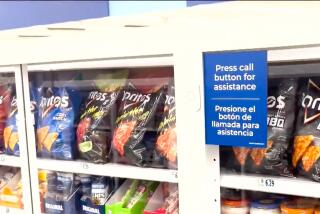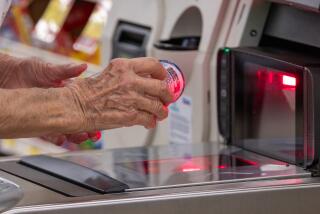Putting the Carts Behind a Force
COSTA MESA — Southern California’s battle for control of the wayward shopping cart is entering a new phase in a grocery store parking lot on Harbor Boulevard.
That’s where Lucky store No. 604 is testing a device to keep the carts on store premises and out of streets, alleys and sight of aggravated residents, who have been trying for years to halt the carts’ travels around the area.
The metal carts, residents and city officials agree, are a hazard and a telltale sign of urban blight. They turn up everywhere from apartment building elevators to the ocean floor, but are most frequently seen in the company of the homeless, who use them to store and transport their belongings.
The abandoned cart “is litter, garbage; it detracts from Costa Mesa as a place to live,” Mayor Joe Erickson said.
The California Grocers Assn. takes a kinder view of the roaming carts, arguing that they are, unfortunately, a necessary form of transport for the goods of the poor and elderly.
“The cities don’t seem to care that everyone doesn’t have two cars in their garage,” said Don Beaver, president of the California Grocers Assn., who complained some cities illegally collect stray carts and hold them for ransom.
The device Lucky began testing earlier this month locks one specially designed wheel of each cart if it passes an invisible electronic barrier at the perimeter of the store parking lot.
Lucky hopes that impediment, along with stern warning signs that removing a cart from the property is a violation of state law, will prevent the daily disappearance of about 30 carts--10% of the store’s inventory of 300.
The device may make its inventor and manufacturer, Actodyne General Inc. of Huntington Beach, popular with officials around the county who have tried everything from imposing fines on store owners to hiring bounty hunters to retrieve the peripatetic carts.
Orange Police Lt. Robert Gustafson, who runs a city hotline that fields reports of wandering shopping carts, said he would be happy to see the device implemented in his town if it works.
“We’d love to see something functional like that instituted by the stores. It will save the city, the stores and the residents from a lot of problems,” Gustafson said.
*
The association estimates there are now about 750,000 carts on the loose on California streets. On an annual basis, the losses cost grocers about $17 million, Beaver said.
The eight counties in Southern California lost about $9 million a year on carts until about three years ago, when the Grocers Assn. started the nonprofit Shopping Cart Retrieval Corp., which pays people to pick up carts when residents report them.
The program has cut grocers’ losses in half, Beaver said. But the remaining carts are proving extremely difficult to retrieve because the people who use them--for toting laundry, trash or, in the case of one motor repair shop, for moving truck engines, Beaver said--simply don’t want to give them back.
“We have to have law enforcement help us sometimes,” Beaver said.
If the system succeeds in a 13-week trial, Lucky Stores may install the device on carts at other stores in high-density areas, where shoppers typically walk home with their groceries.
“Our object is to keep the shopping cart in the parking lot,” said Judy Decker, a spokeswoman for the Salt Lake City-based supermarket chain. “We will look at a number of things, including customer reaction and cost.”
The cost of the system, still in the testing stage, has yet to be determined, said Don Lace Jr., Actodyne’s president. However, a spokesperson for Polytracker Inc., a San Jose company that is marketing a similar product in Northern California, said the company charges $50 to $60 per wheel.
That may make the system prohibitively expensive for supermarkets, according to Beaver, the Grocers Assn. president, who said Southern California merchants are waiting to see how Lucky’s experiment goes before getting on the bandwagon.
*
During its first week, the locking wheel seemed to bother a few shoppers at the Costa Mesa store, but delight many others. “What a clever idea,” said Janie O’Maley, 65, who lives in an apartment building across the street, where dozens of shopping carts from many different stores can be found on any day. Though she praised the carts’ usefulness, O’Maley said: “It got so you were tripping over them.”
One customer who said she used the carts to ferry home groceries found the new system a problem. Angelica Torres, 30, said she used to take seven or eight bags of groceries home in a cart when her husband had the car, but always returned the emptied cart promptly.
“For a few people [who keep or damage the carts], all of us pay,” Torres said as she waited for her husband outside the store Monday.
Another woman said that, aside from having trouble moving a locked cart into the store, she welcomed the system--particularly if savings from it would lower her grocery bill. (Store employees have a hand-held device similar to a garage door opener that can disable the system if a cart becomes locked.)
“It’s a good thing if it is going to save customers money,” said Irma Hernandez, 33, of Westminster. “I expect to see it here,” she said, pointing to her receipt.
The new wheels have been installed on 64 of the store’s 300 carts, Lace said. He said he got the idea for “The Wheel,” as the company has named the device, from a 1993 magazine story on shopping cart retrieval companies in Southern California.
The test at the Lucky store here is the first in the nation for Actodyne’s invention. Lace conceded he wasn’t quite ready for the interest the product has inspired.
“We are still fine-tuning the system,” Lace said, including moving the operative wheel from the rear of the cart to the front for more resistance.
But if clever Costa Mesa shoppers are any indication, it may take widespread use of restraining systems to make them work. As Torres grew weary of waiting for her husband to pick her up Monday, a friend arrived up with a cart from a nearby Kmart store, loaded up the groceries and toted them to Torres’ house.
That saved Lucky one cart--at the expense of Kmart shoppers.
(BEGIN TEXT OF INFOBOX / INFOGRAPHIC)
Marketing Plan
A wheel-locking device is designed to keep shopping carts within the perimeters of supermarket parking lots. The device works on the same principle as a garage-door opener. A closer look:
How it works:
1. Cart rolls over cable, transmitting radio wave
2. Sensor inside hollow, waterproof wheel detects radio wave
3. Brake activates, expands; teeth grip inside of tire, stopping wheel
* Source: Actodyne General Inc.; Researched by APRIL JACKSON / Los Angeles Times
More to Read
Sign up for Essential California
The most important California stories and recommendations in your inbox every morning.
You may occasionally receive promotional content from the Los Angeles Times.










